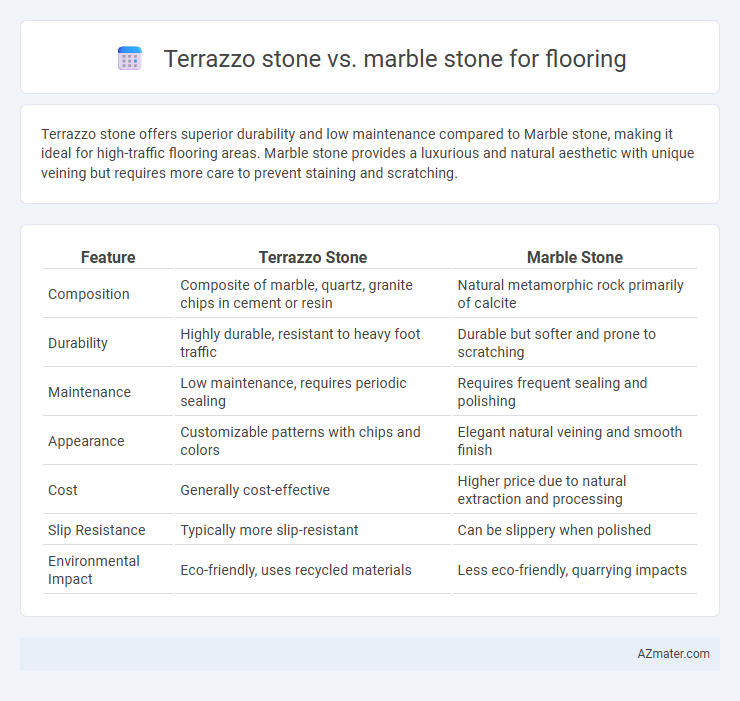Terrazzo stone offers superior durability and low maintenance compared to Marble stone, making it ideal for high-traffic flooring areas. Marble stone provides a luxurious and natural aesthetic with unique veining but requires more care to prevent staining and scratching.
Table of Comparison
| Feature | Terrazzo Stone | Marble Stone |
|---|---|---|
| Composition | Composite of marble, quartz, granite chips in cement or resin | Natural metamorphic rock primarily of calcite |
| Durability | Highly durable, resistant to heavy foot traffic | Durable but softer and prone to scratching |
| Maintenance | Low maintenance, requires periodic sealing | Requires frequent sealing and polishing |
| Appearance | Customizable patterns with chips and colors | Elegant natural veining and smooth finish |
| Cost | Generally cost-effective | Higher price due to natural extraction and processing |
| Slip Resistance | Typically more slip-resistant | Can be slippery when polished |
| Environmental Impact | Eco-friendly, uses recycled materials | Less eco-friendly, quarrying impacts |
Introduction to Terrazzo and Marble Flooring
Terrazzo flooring consists of marble, quartz, granite, or glass chips embedded in a cement or epoxy resin binder, offering a durable, customizable surface with a speckled aesthetic. Marble flooring, made from natural metamorphic stone, provides a classic, elegant look with unique veining patterns and a polished finish ideal for high-end interiors. Both materials enhance flooring durability and aesthetics, with terrazzo excelling in versatility and marble prized for timeless luxury.
Composition and Material Differences
Terrazzo stone consists of a composite material made from chips of marble, quartz, granite, or glass set in a cement or epoxy binder, offering customizable colors and patterns. Marble stone is a natural metamorphic rock primarily composed of recrystallized calcium carbonate, prized for its elegant veining and smooth texture. The key material difference lies in terrazzo's engineered mix for durability and design flexibility versus marble's organic formation that provides natural beauty but requires more maintenance.
Durability and Longevity Comparison
Terrazzo stone flooring offers superior durability due to its composite nature, combining marble chips with a cement or epoxy binder, which resists cracks and wear better than natural marble. Marble stone, while aesthetically appealing, is softer and more prone to scratches, stains, and erosion from acidic substances, reducing its longevity in high-traffic areas. Terrazzo's enhanced toughness and low maintenance requirements make it a more sustainable flooring option for long-term use compared to marble.
Aesthetic Appeal and Design Versatility
Terrazzo stone offers a highly customizable surface with a vibrant mix of marble, quartz, granite, or glass chips embedded in a cement or epoxy base, allowing for intricate patterns and bold color combinations that surpass the natural veining of marble. Marble stone provides an elegant, classic aesthetic defined by its smooth, polished texture and unique, flowing veining, which imparts a timeless luxury ideal for sophisticated interiors. Terrazzo's design versatility excels in modern and eclectic spaces with varying textures and hues, whereas marble remains preferred for traditional and upscale environments due to its irreplaceable natural beauty.
Installation Process and Requirements
Terrazzo stone flooring involves a labor-intensive installation process where a mix of marble, quartz, granite chips, and binder is poured, cured, ground, and polished on-site, requiring specialized skills and equipment. Marble stone flooring installation demands precise cutting, fitting, and adhesive application with professional-grade tools to ensure proper alignment and sealing. Both materials require a stable, clean substrate, but terrazzo often needs longer curing times, while marble calls for meticulous handling to prevent cracking and ensure lasting durability.
Maintenance and Cleaning Needs
Terrazzo stone requires minimal maintenance due to its high durability and resistance to stains, making it easy to clean with regular sweeping and occasional mopping using pH-neutral cleaners. Marble stone demands more careful maintenance as it is porous and prone to etching and staining, necessitating frequent sealing and the use of gentle, non-acidic cleaning products to preserve its polished surface. Both materials benefit from immediate spill cleanup, but terrazzo offers a more low-maintenance option for high-traffic flooring areas.
Cost Analysis: Terrazzo vs Marble
Terrazzo flooring typically costs between $20 to $50 per square foot, making it a more budget-friendly option compared to marble, which ranges from $40 to $100 per square foot. Installation expenses for terrazzo are generally lower due to its easier preparation and faster curing times, while marble requires skilled labor for cutting and polishing, increasing labor costs. Long-term maintenance costs for terrazzo are also reduced, as it is more resistant to stains and cracks, whereas marble demands frequent sealing and specialized care to preserve its appearance.
Environmental Impact and Sustainability
Terrazzo stone flooring is more environmentally sustainable than marble due to its use of recycled materials like glass, marble chips, and cement, reducing landfill waste and resource extraction. Marble extraction involves significant quarrying that leads to habitat destruction, high water consumption, and energy-intensive processing, resulting in a larger carbon footprint compared to terrazzo. Terrazzo's durability and lower maintenance needs extend its lifespan, minimizing replacement frequency and environmental impact over time.
Popular Applications and Usage Trends
Terrazzo stone is extensively used in commercial spaces like airports, schools, and hospitals due to its durability, low maintenance, and eco-friendly composition. Marble stone remains popular in luxury residential flooring and high-end hotels for its elegant appearance and natural veining patterns. Current usage trends show a growing preference for terrazzo in sustainable architecture, while marble continues to be favored for classic and upscale interior designs.
Choosing the Right Stone for Your Flooring
Terrazzo stone offers exceptional durability and low maintenance, making it ideal for high-traffic areas due to its composite material of chips from marble, quartz, and granite bound by epoxy or cement. Marble stone provides a classic, luxurious aesthetic with natural veining, but requires regular sealing and careful upkeep to prevent staining and etching. Choosing the right stone depends on balancing budget, design preference, and the flooring's exposure to wear, with terrazzo favored for longevity and marble chosen for distinctive elegance.

Infographic: Terrazzo stone vs Marble stone for Flooring
 azmater.com
azmater.com